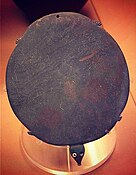Amratian culture
| Dates | circa 4400 BC — circa 3500 BC |
|---|---|
| Major sites | El-Amra |
| Preceded by | Tasian culture, Badari culture, Merimde culture |
| Followed by | Gerzeh culture (Naqada II) |
The Amratian culture, also called Naqada I, was a culture of prehistoric Upper Egypt. It lasted approximately from 4000 to 3500 BC.[1]
Overview


The Amratian culture is named after the archaeological site of el-Amra, located around 120 km (75 mi) south of Badari in Upper Egypt. El-Amra was the first site where this culture group was found without being mingled with the later Gerzeh culture (Naqada II). However, this period is better attested at the Nagada site, thus it also is referred to as the Naqada I culture.[2] Black-topped ware continued to be produced, but white cross-line ware, a type of pottery which has been decorated with close parallel white lines being crossed by another set of close parallel white lines, begins to be produced during this time. The Amratian falls between S.D. 30 and 39 in Flinders Petrie's sequence dating system.[3][4]
The Amratians possessed slaves, and constructed rowboats of bundled papyrus in which they could sail the Nile.[5] Trade between the Amratian culture bearers in Upper Egypt and populations of Lower Egypt is attested during this time through new excavated objects. A stone vase from the north has been found at el-Amra. The predecessor Badarian culture had also discovered that malachite could be heated into copper beads;[a] the Amratians shaped this metal by chipping.[5] Obsidian and a very small amount of gold were both imported from Nubia during this time.[2][3] Trade with the oases also was likely.[2] Cedar was imported from Byblos, marble from Paros, as well as emery from Naxos.[5]


New innovations such as adobe buildings, for which the Gerzeh culture is well known, also begin to appear during this time, attesting to cultural continuity. However, they did not reach nearly the widespread use that they were known for in later times.[6] Additionally, oval and theriomorphic cosmetic palettes appear to be used in this period. However, the workmanship was still very rudimentary and the relief artwork for which they were later known is not yet present.[7]
Each Amratian village had an animal deity; amulets were worn of humans and various animals including birds and fish. Food, weaponry, statuettes, decorations, malachite, and occasionally dogs were buried with the deceased.[5]
Early cosmetic palettes
Siltstone was first utilized for cosmetic palettes by the Badari culture. The first palettes used in the Badarian Period and in Naqada I were usually plain, rhomboidal or rectangular in shape, without any further decoration. It is in the Naqada II period in which the zoomorphic palette is most common.
-
Mudstone cosmetic palette in the form of a turtle with inlaid bone eyes (one missing). Predynastic, Naqada I. 4000-3600 BC. EA 37913 (British Museum)
-
Mudstone palette in the form of a hippopotamus. Predynastic, Naqada I. 4000-3600 BC. EA 29416. (British Museum)
-
Naqada I-II palette for blending cosmetics
Relative chronology
See also
References
Footnotes
- ^ Copper may have also been imported from the Sinai Peninsula or perhaps Nubia.
Citations
- ^ Shaw, Ian, ed. (2000). The Oxford History of Ancient Egypt. Oxford University Press. p. 479. ISBN 0-19-815034-2.
- ^ a b c Grimal, Nicolas (1992). A History of Ancient Egypt. Blackwell. p. 28. ISBN 0-631-17472-9.
- ^ a b Gardiner, Alan (1964). Egypt of the Pharaohs. Oxford: University Press. p. 390.
- ^ Newell, G.D. (2012). The relative chronology of PNC I. A new chronological synthesis for the Egyptian Predynastic. ex.cathedra Press.
- ^ a b c d Smith, Homer W. (2015) [1952]. Man and His Gods. Lulu Press. pp. 16–17. ISBN 9781329584952.
- ^ Redford, Donald B. (1992). Egypt, Canaan, and Israel in Ancient Times. Princeton: University Press. p. 7. ISBN 0-691-03606-3.
- ^ Gardiner, Alan (1964). Egypt of the Pharaohs. Oxford: University Press. p. 393.





